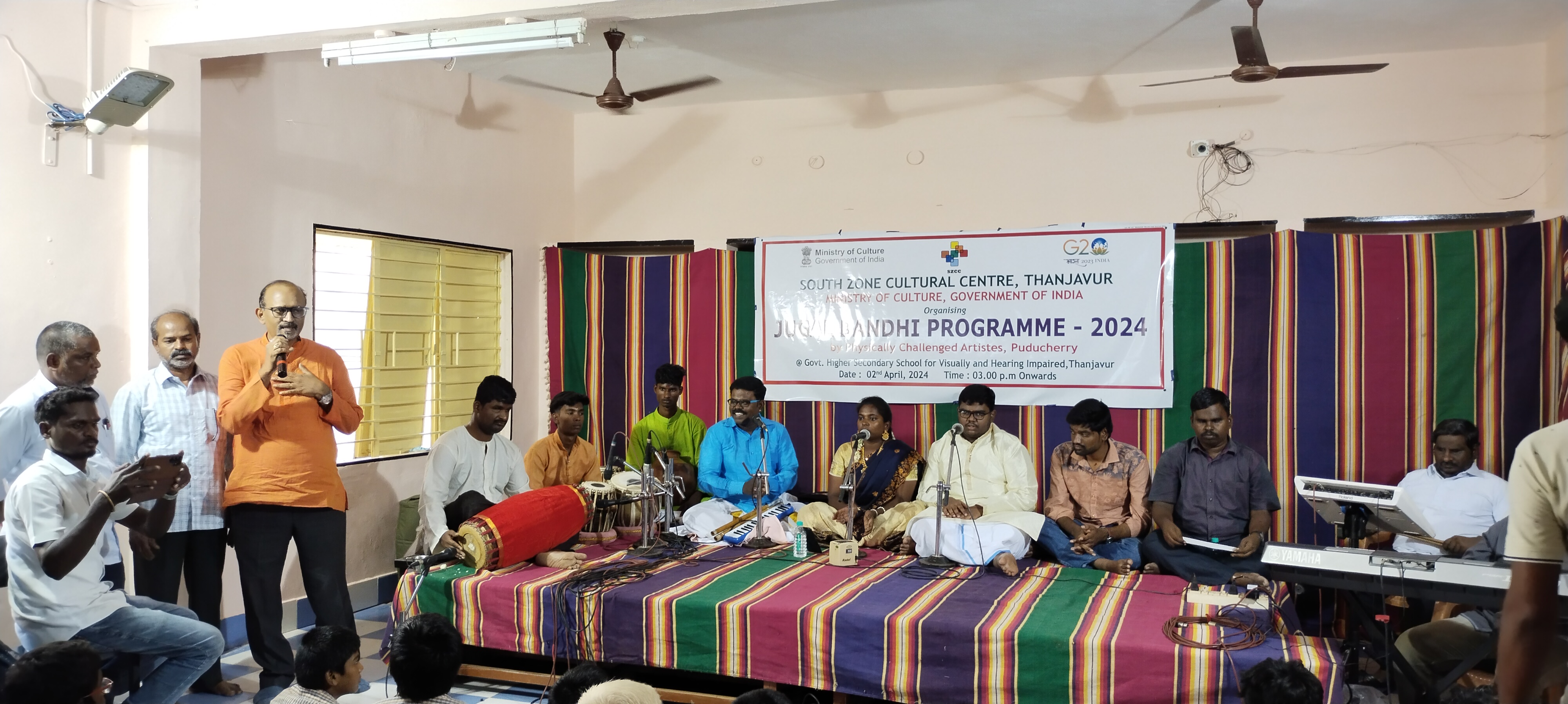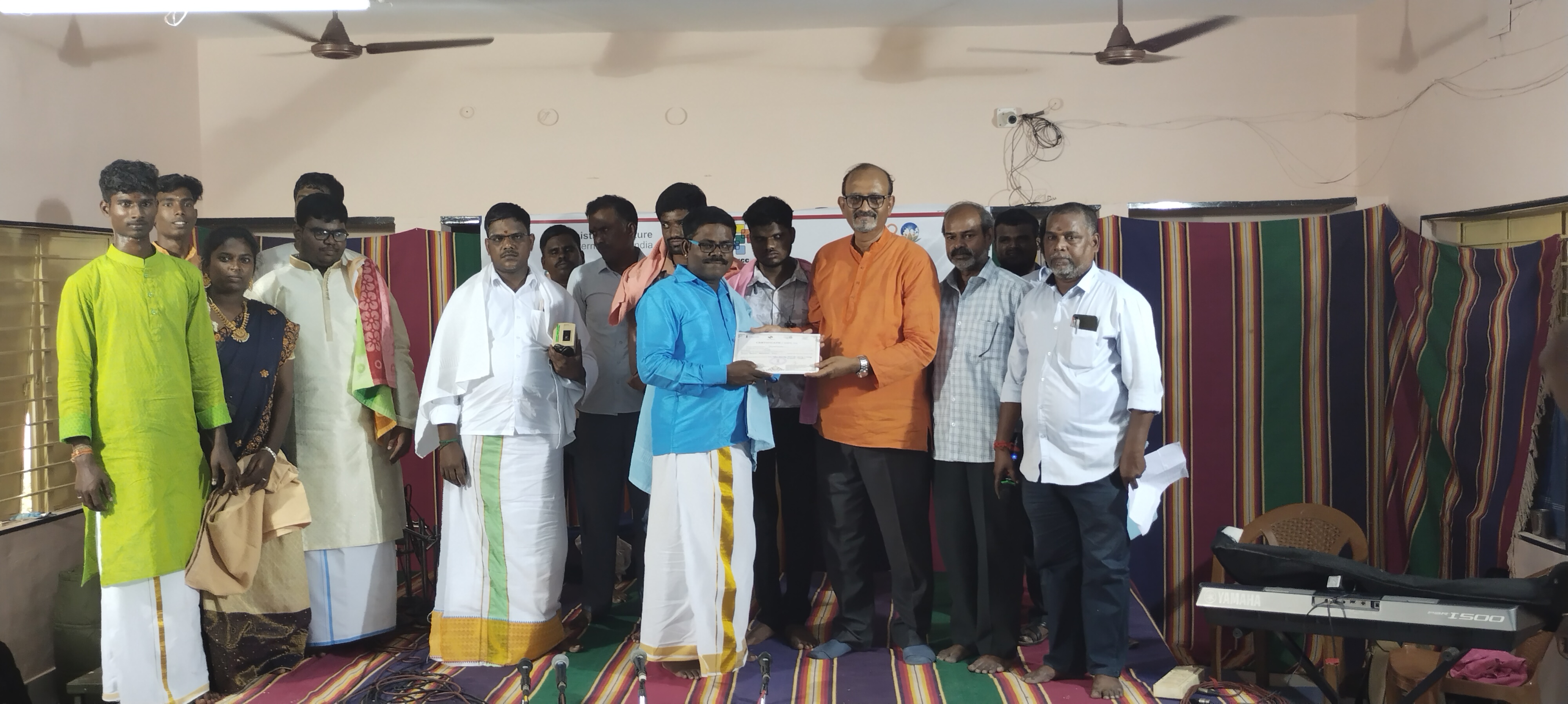Puli Attam
Puli Attam is performed by young men with painted bodies in colours yellow and black, complete with fangs, head gear with ears, paws with claws and long tail, simulating the prancing, pouncing tiger in every ferocious move. Wildly beating drums add frenzy to the performance. Sometimes, a goat is tied and brought along with the dancers, who pretend to pounce on it and kill it. This dance is regularly performed during temple festivals, drawing large crowds.
Oyilattam
Oyil means beauty. This dance is hence the dance of beauty. Traditionally, it is danced only by men. Ten years ago women also began to participate. This dance is prevalent in the south districts and Kongu Nadu in particular. First a few people will stand in a row and start dancing with rhythmic steps with musical accompaniment. Intricate steps are used in martial arts, such as Silambattam. Then gradually the row will become longer as the new comers and guests all join and dance along as they like. The dancers wear ankle-bells. Normally, the dance is performed with the accomplishment of musical instruments and songs. It is performed near the temples or public places in the morning and evening hours, at times even till midnight. Styles of Oyilattam differ from place to place.
Theru Koothu Normally conducted during village festivals, during the months of Panguni and Aadi. This is performed where three or four streets meet; in open air, the place being lit by gas lights. A wooden bench is set up to seat the singers and the musical troupe. Here, make-up and costumes are considered of prime importance. Only men take part; the female roles also played by them. The performance consists of stoy-telling, dialogue-rendering, songs and dance, all performed by the artistes. Thus the ariste should have a very good performing ability, being an all-rounder. The stories are taken from Puranas, epics such as Ramayana and Mahabharata, and also local folklore. The play starts in the late evening and gets over only during the small hours of the nights. The performance is so captivating that the audience are spell-bound unaware of the longs hours. Theru Koothu is more popular in the northern districts of Tamilnadu. The Koothu can be categorised as Nattu Koothu, including Vali Koothu, Kuravai Koothu etc. Samaya Koothu dealing with religious topics, Pei Koothu including Thunangai Koothu and Porkala Koothu dealing with martial events.
Bagavatha Nadanam
This dance is performed inside a temple, around a lamp. The purpose is to worship Lord Krishna, and celebrate his frolics with the gopikas. This is performed during Ramanavami and Gokulashtami.
Bommalattam (Puppet Show)
Puppet shows are held in every village during festivals and fairs. Many different kinds of puppets are used for this show - cloth, wood, leather, etc. They are manipulated through strings or wires. The persons stand behind a screen and the puppets are held in front. The stories enacted in the puppet shows are from puranas, epics and folklore. These shows are very entertaining and hold both adults and children enthralled for many hours.
Silambattam
Kol silambam or fighting with a long stick and even with swords is a martial art from the days of Tamil Kings. Fights were characterized by moves of self-defense, practice of skillful methods of approaching the opponent, overpowering and subduing him, and finally teaching him a lesson, all to put an end to violence. A violent fighting art has metamorphosed into a non-violent form of folk dance, adding stepping styles following the measure of time. It also teaches the performer the methods of the self-defense in modern day world.
This art is widely practiced in Tamilnadu and considered to be the game of bravery. The name Silambam refers to the long staff used in the game, which is made out of bamboo or red teak wood. Silambam is not only an art or game, it’s a skill that teaches discipline, presence of knowledge, humanity, peace, brotherhood, and even more subtle things. The master is addressed as Assan in Silambam. Unlike Karate or Kunfu, there is no level in Silambam, once the student is well versed in the art, he will be given a red band and declared as Assan. It can be seen both as a healthy practice, like a Yoga, with beautifully flowing techniques, and as an efficient, combative system.
Kai Silambu Attam
This dance is performed in temples during Amman festivals or Navaratri festival. The dancers wear ankle-bells and hold anklets or silambu in their hands, which make noise when shaken. They perform various stepping styles jumps. The dance is in praise of all female deities, the most preferred being the powerful angry goddess - Kali or Durga.
Poikkal Kudirai Aattam
This dance is one of the most ancient folk dances of Tamilnadu. This dance got other names such as Puravi attam (Horse dance) and Marakkaladal (wooden leg dance. As per the name, the dancer, dances with upper half body of the horse tied to his/ her waist. This dance is performed only for happy occasions like temple processions, festivals, celebrations, and village gatherings. This dance is the pioneer for many dances in India including Saithikoda in Orissa, Theelu Gurram in Andhra Pradesh, Kachikoti in Rajasthan and Kuthikali in Kerala. It’s a joyful experience to see the Poikal Kuthirai dancer dance for drum beats (Melam, Kottu), their spirit will tend the onlookers to join them and dance along with them.
Kavadi attam
Kavadi attam is one of the Tamilnadu‘s folk dances. This dance is a form of offering dedicated to Lord Muruga to please him and seek his immense blessing. Though is a religious ritual practiced by devotees, it’s basically a dance that needs proper guidance and co-ordination. People of Tamilnadu and Kerala and Malaysia are well versed in performing this art.
The ancient Tamils when they went on pilgrimage, carried the offerings to the gods tied on the either end of the long stick, which was balanced on the shoulders. In order to lessen the boredom of the long travel they used to sing and dance about the gods. Kavadi Aattam has its origin in this practice. Special songs were created to be sung while carrying the Kavadi Sindhu. This dance is performed only by men. It is done by balancing a pole with pots fixed on either end, filled with milk or coconut water.
Kolaattam
Kolaattam is an ancient village art. This is mentioned in Kanchipuram as 'Cheivaikiyar Kolattam', which proves its antiquity. This is performed by women only, with two sticks held in each hand, beaten to make a rhythmic noise. Pinnal Kolaattam is danced with ropes which the women hold in their hands, the other of which are tied to a tall pole. With planned steps, the women skip over each other, which forms intricate lace-like patterns in the ropes. As coloured ropes are used, this lace looks extremely attractive. Again, they unravel this lace reversing the dance steps. This is performed for ten days, starting with the Amavasi or New moon night after Deepavali.
Mayil Attam
Maliy Attam means the "Peacock dance". In this dance girls adorn themselves as peacocks and dance elegantly. Costume is very important in dances like this. Other similar dances are, Kaalai Attam (dressed as a bull), Karadi Attam (dressed as a bear) and Aali Aattam (dressed as a demon) which are performed in the villages during village get-togethers. Vedala Aattam is performed wearing a mask depicting demons.
Karagaattam
Karagaattam is a popular village dance in Tamilnadu, this dance played a vital role in 18s and 19s, where every function in the villages are incomplete without this Karagattam. It is a very vibrant dance, consisting of few dancers dressed up in gorgeous attires, and balancing a pot in their head, and dancing to the music with josh. This dance is dedicated to the rain goddess Mari, for her immense blessings. Sometimes this dance is performed purely for entertainment. In Sangam literature, it is mentioned as 'Kudakoothu'. This dance has two divisions - one, Aatta Karagam and the other 'Sakthi Karagam'. This dance symbolizes merriment, happiness and fervor. The important musical instruments used in this dance are melam, nathaswaram, and thavil. Acrobatics similar to circus are included - such as dancing on a rolling block of wood, up and down a ladder, threading a needle while bending backwards and so on.
Thapattam
Thapattam is a Folk Dance of Tamil Nadu which has been known as Paraiattam in ancient Sangam Literatures. Parai is an instrument which is used for the declaration and the proclamation of Ancient Tamil King's message and Orders to the Public. During Bhakti cult both the Saivite and Vaishnavite Saints have referred Parai as one of the ritual instruments in the worshipping patterns through penances. Sri Andal, the counter part of Meera in Tamil Nadu mentions this instruments, Parai in so many stanzas of her work Thirupavai. The Parai acquarried the name Thappu based on the action of beating on the instrument Parai. Thappu is always associated with beats and its dance. The uniqueness of Thappattam is that both the player and the dancer are same. The beats of the Drum and the movements of the body meet in unison so as to become an expressive dance form. It is an Artform of the suppressed class. Unfortunately the higher caste people invite Thappattam only for the funeral processions. But as for as the suppressed community is concerned Thappattam is an Artform which extends from a birth of a child to the death of a man or woman.Thappattam is played at each and every auspicious functions of a family like child's birth, puberty, marriages and the worship of the community deities. The patterns of the beats of Drums varies according to its performance in an auspicious occasion and funeral ceremony. The South Zone Cultural Centre took venture in the year 1986 under the guidance of Prof. Ramanujam to rejuvenate the vibrants of the Artform with a training program given by a local Guru to the Thappattam players of Reddipalayam of Thanjavur District.This has made an impact on the Socio-Cultural realm of Tamil Nadu, so much so that Thappattam has become a center of focus of the Modern Theatre practioners, creative dancers, cultural nights, cultural exchange programmes and cultural studies. The traditional Thappattam troupe of Reddipalayam have also performed abroad.







 ""GeM Bid Document for Permanent Craft Stalls at SZCC Premises, Thanjavur""
""GeM Bid Document for Permanent Craft Stalls at SZCC Premises, Thanjavur"".jpg)







